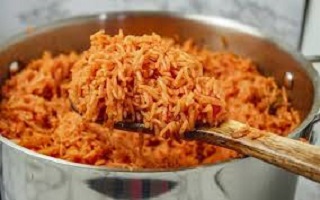Jollof Rice Benefits: Is Jollof Rice Healthy?
Jollof Rice Benefits: Is Jollof Rice Healthy?

Jollof Rice Benefits: Best Answer
The Jollof rice is a beloved dish celebrated for its rich flavors and cultural significance across many parts of the world. However, when it comes to its healthiness, there are several factors to consider.
On the positive side, jollof rice typically contains ingredients like tomatoes, onions, bell peppers, and other vegetables, providing essential vitamins, minerals, and fiber.
These ingredients contribute to its vibrant color and also add nutritional value. Additionally, if prepared with lean protein sources such as chicken, fish, or beans, jollof rice can be a well-balanced meal.
However, the healthiness of jollof rice can be compromised depending on the preparation method and ingredients used. Traditional recipes often call for a significant amount of oil or butter to sauté the vegetables and cook the rice, which can increase the dish’s calorie and fat content.
Furthermore, the addition of processed ingredients like bouillon cubes or excessive salt can elevate its sodium levels, which may not be ideal for individuals with hypertension or other health concerns.

Another consideration is portion size. Jollof rice is often served in generous portions, which can lead to overeating and contribute to weight gain if not consumed in moderation.
To make jollof rice healthier, consider using healthier cooking methods such as baking or steaming the rice instead of frying. You can also reduce the amount of oil used or opt for healthier alternatives, like olive oil. Incorporating more vegetables and lean protein into the dish while minimizing processed ingredients can enhance its nutritional profile.
Ultimately, whether jollof rice is deemed healthy depends on how it is prepared and consumed. With mindful ingredient choices and portion control, it can certainly be enjoyed as part of a balanced diet.
Jollof Rice Benefits: About Jollof rice
Jollof rice is a popular West African dish made with rice, tomatoes, onions, and various spices. While it’s primarily enjoyed for its delicious taste and cultural significance, there are some potential benefits associated with its ingredients:
Jollof Rice Benefits: Nutrient-rich
Jollof rice typically contains vegetables such as tomatoes, onions, and sometimes bell peppers, which are rich in vitamins, minerals, and antioxidants. These nutrients are essential for overall health and well-being.
Jollof Rice Benefits: Fiber
Rice, especially when it’s whole grain, provides dietary fiber, which is important for digestive health. Fiber helps regulate bowel movements, prevents constipation, and may reduce the risk of certain diseases such as heart disease and type 2 diabetes.
Jollof Rice Benefits: Protein
Depending on the recipe, jollof rice may contain protein sources such as chicken, fish, or beans. Protein is essential for muscle repair and growth, immune function, and overall health.
Jollof Rice Benefits: Healthy fats
Some versions of jollof rice may include ingredients like palm oil or groundnut oil, which provide healthy fats that are important for brain function, hormone production, and cell structure.
Jollof Rice Benefits: Satiety
The combination of rice and protein in jollof rice can help promote feelings of fullness and satisfaction, which may prevent overeating and aid in weight management.
Jollof Rice Benefits: Cultural significance
While not a direct health benefit, the cultural significance of jollof rice can contribute to overall well-being by fostering a sense of community, identity, and tradition.
However, it’s important to note that the health benefits of jollof rice can vary depending on factors such as portion size, cooking methods, and additional ingredients used in the recipe. Enjoying jollof rice as part of a balanced diet that includes a variety of nutrient-rich foods is key to reaping its potential benefits.

How to Eat Jollof Rice
Jollof rice is undeniably a staple in Nigerian cuisine, and its presence at gatherings adds to the vibrancy and joy of these occasions.
The flexibility of enjoying it with either a spoon or hands speaks to the informal, communal nature of many Nigerian meals, where the focus is on enjoying food together with loved ones.
Pairing jollof rice with fried plantains and a wet salad is a common and delightful combination. The sweetness of the plantains complements the savory flavors of the rice, while the refreshing crunch of the salad provides a nice contrast in texture.
This trio creates a well-rounded meal that satisfies both the palate and the appetite.
The cultural significance of jollof rice in Nigeria goes beyond its taste; it symbolizes unity, celebration, and the richness of Nigerian culinary heritage.
Whether enjoyed at a bustling party or a cozy family dinner, jollof rice holds a special place in the hearts and memories of Nigerians and food enthusiasts worldwide.



Pingback: Palm Oil Jollof Rice: Nigerian Native Dish (Iwuk Edesi) - 9jafoods